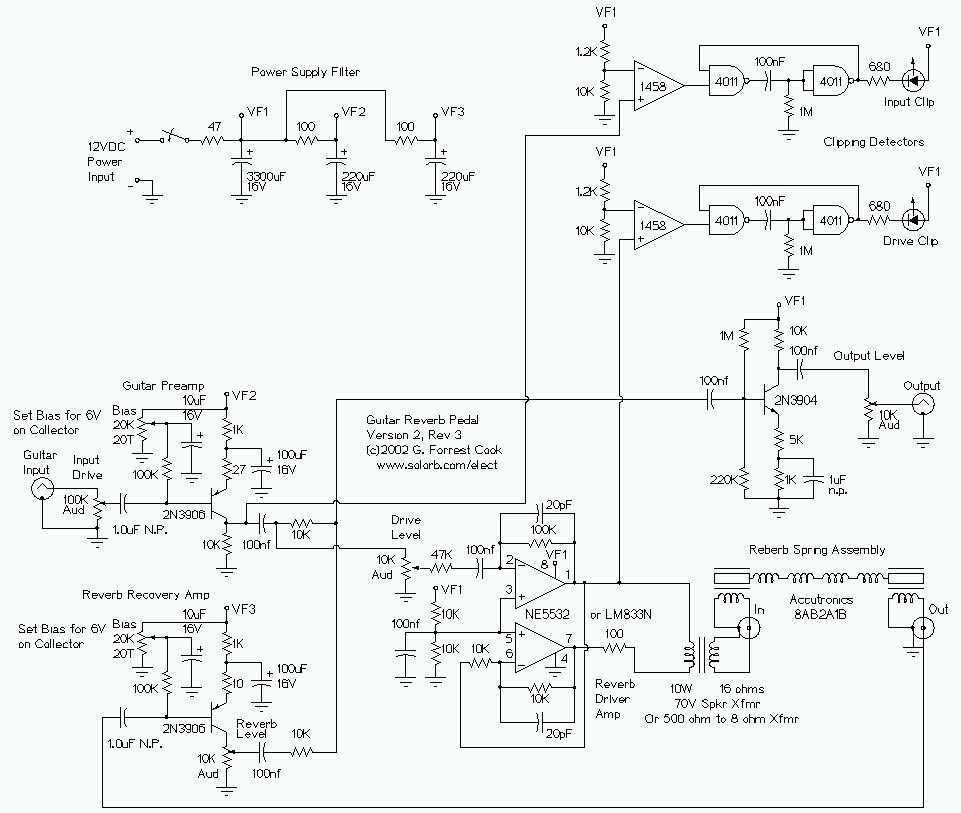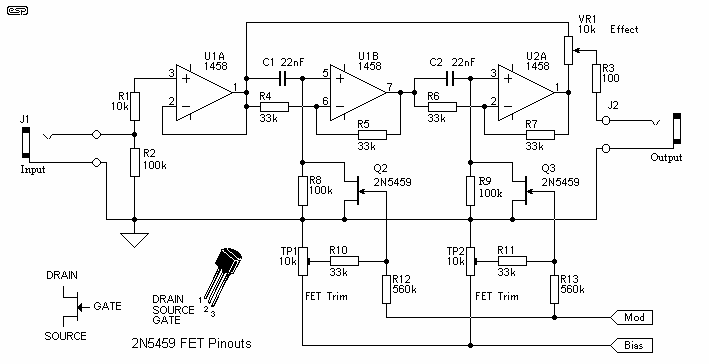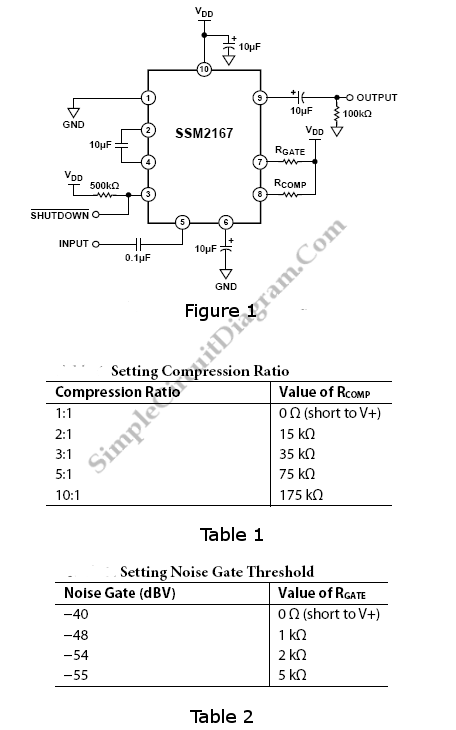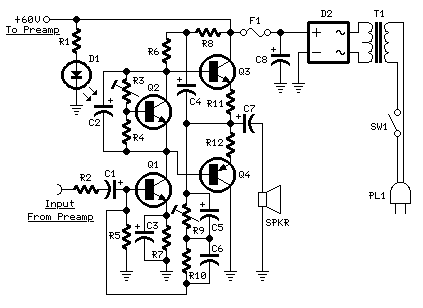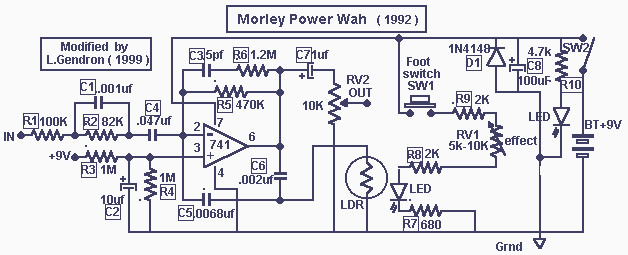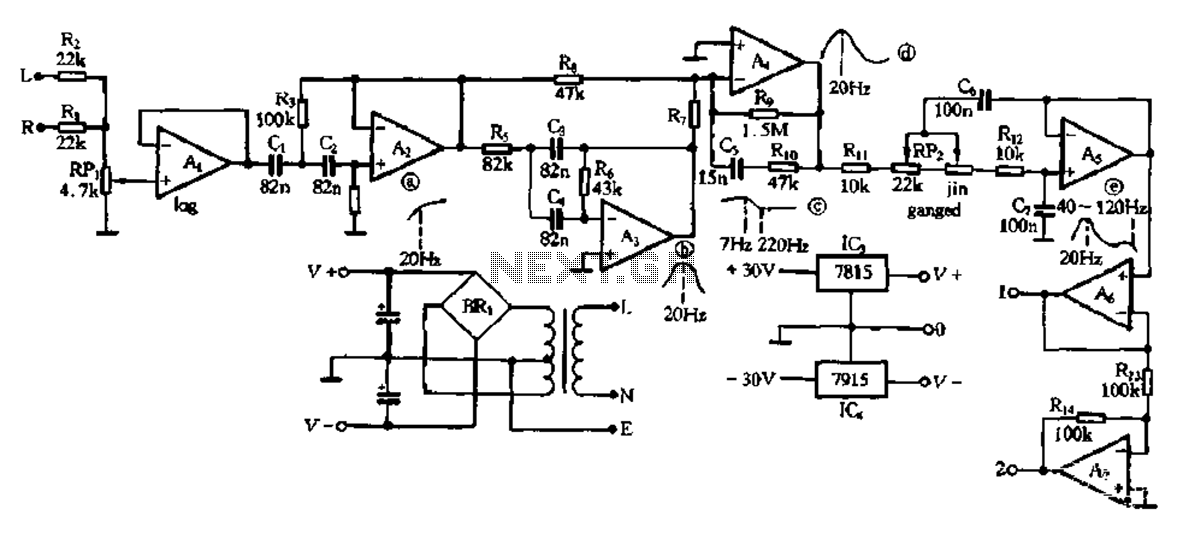
Guitar and bass tuner
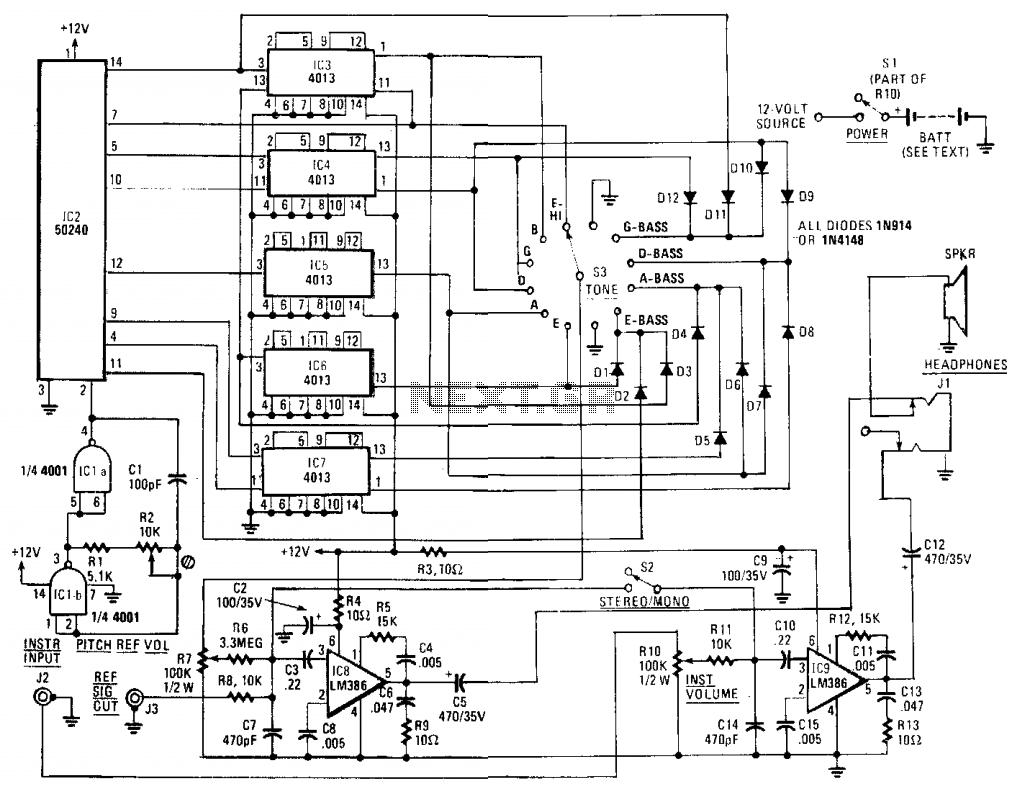
The core component of the circuit is IC2, a 50240 top-octave generator. This device utilizes a single input frequency to produce all twelve notes of the musical scale. The input signal is supplied by IC1, a 4001 quad 2-input NOR gate. Two sections of this IC are configured to create an oscillator that operates at approximately 2 MHz, with the frequency adjustable via trimmer potentiometer R2. Dual D flip-flops, IC3-IC7, function as frequency dividers, reducing the upper-octave frequencies from IC2 to generate the lower-frequency notes necessary for pitch references. Each bass pitch reference is composed of three notes, which are derived from various outputs of IC2-IC7 through isolation diodes D1-D12. All signals are routed to the TONE switch, S3, with the wiper arm connected through R7 to the input of the audio power amplifier IC8, an LM386. This resistor serves as a volume control for the pitch reference. Another LM386, IC9, amplifies the instrument being tuned, with R10 acting as its volume control. The outputs of IC8 and IC9 are coupled through capacitors C5 and C12, respectively, to the headphone jack, J1. The S2 STEREO/MONO switch is utilized to mix the reference and instrument signals at IC9 for mono operation. Power is supplied by eight "AA" cells connected in series.
The circuit design incorporates a top-octave generator (IC2) which is pivotal in synthesizing a range of musical notes. The 50240 chip generates a complete set of twelve notes based on a single frequency input, facilitating the creation of harmonically rich sounds essential for musical applications. The input frequency is generated by an oscillator formed from two sections of the 4001 quad 2-input NOR gate (IC1), allowing for precise frequency control and modulation through the trimmer potentiometer (R2). This flexibility enables users to adjust the pitch output to suit various musical contexts.
Frequency division is accomplished by the dual D flip-flops (IC3-IC7), which effectively reduce the frequencies produced by the top-octave generator to create the necessary lower frequencies for bass pitch references. The output from these flip-flops is then routed through isolation diodes (D1-D12), ensuring that each note remains distinct and free from interference, which is crucial for maintaining sound quality in musical applications.
The TONE switch (S3) allows for user interaction with the generated signals, enabling the selection of different tones. The audio power amplifier (IC8, LM386) amplifies the pitch reference signal, with R7 serving as a volume control, allowing the user to adjust the output level. Similarly, the second LM386 (IC9) amplifies the signal from the instrument being tuned, with R10 providing further volume control.
The outputs from both amplifiers are coupled to a headphone jack (J1) through capacitors (C5 and C12), ensuring that the audio signals are appropriately filtered to prevent DC offsets from reaching the headphones. The S2 switch offers a choice between stereo and mono output, allowing for versatile audio configurations depending on user preference or specific application requirements.
Finally, the circuit is powered by eight "AA" cells arranged in series, providing a reliable power source for sustained operation. This design ensures that the circuit remains portable and user-friendly, making it suitable for various tuning and musical applications.The heart of the circuit is IC2, a 50240 top-octave generator. That device uses a single input-frequency to generate all twelve notes of the musical scale. The input signal is provided by IC1, a 4001 quad 2-input NOR gate. Two sections of that IC are used to form an oscillator that runs at approximately 2 MHz. The frequency can be adjusted by trimmer potentiometer R2. Dual D flip-flops, IC3-IC7, are used as frequency dividers. They divide down the upper-octave frequencies from IC2, thus generating the lower-frequency notes required for the pitch references. The chords for the bass pitch-references are composed of three notes each. Those notes are taken from various outputs of IC2-IC7 through isolation diodesD1-D12. All signals are routed to the TONE switch, S3. The wiper arm of that switch is connected through R7 to the input of audio power-amplifier IC8, an LM386. The resistor acts as a volume control for the pitch reference. Another LM386, IC9, serves as an amplifier for the instrument being tuned, with RIO acting as its volume control.
The outputs of IC8 and IC9 are coupled, through C5 and C12 respectively, to the headphone jack, J1. Switch S2 STEREO/MONO is used to mix the reference and instrument signals at IC9 for mono operation. Power is supplied by eight "AA" cells connected in series. 🔗 External reference
The circuit design incorporates a top-octave generator (IC2) which is pivotal in synthesizing a range of musical notes. The 50240 chip generates a complete set of twelve notes based on a single frequency input, facilitating the creation of harmonically rich sounds essential for musical applications. The input frequency is generated by an oscillator formed from two sections of the 4001 quad 2-input NOR gate (IC1), allowing for precise frequency control and modulation through the trimmer potentiometer (R2). This flexibility enables users to adjust the pitch output to suit various musical contexts.
Frequency division is accomplished by the dual D flip-flops (IC3-IC7), which effectively reduce the frequencies produced by the top-octave generator to create the necessary lower frequencies for bass pitch references. The output from these flip-flops is then routed through isolation diodes (D1-D12), ensuring that each note remains distinct and free from interference, which is crucial for maintaining sound quality in musical applications.
The TONE switch (S3) allows for user interaction with the generated signals, enabling the selection of different tones. The audio power amplifier (IC8, LM386) amplifies the pitch reference signal, with R7 serving as a volume control, allowing the user to adjust the output level. Similarly, the second LM386 (IC9) amplifies the signal from the instrument being tuned, with R10 providing further volume control.
The outputs from both amplifiers are coupled to a headphone jack (J1) through capacitors (C5 and C12), ensuring that the audio signals are appropriately filtered to prevent DC offsets from reaching the headphones. The S2 switch offers a choice between stereo and mono output, allowing for versatile audio configurations depending on user preference or specific application requirements.
Finally, the circuit is powered by eight "AA" cells arranged in series, providing a reliable power source for sustained operation. This design ensures that the circuit remains portable and user-friendly, making it suitable for various tuning and musical applications.The heart of the circuit is IC2, a 50240 top-octave generator. That device uses a single input-frequency to generate all twelve notes of the musical scale. The input signal is provided by IC1, a 4001 quad 2-input NOR gate. Two sections of that IC are used to form an oscillator that runs at approximately 2 MHz. The frequency can be adjusted by trimmer potentiometer R2. Dual D flip-flops, IC3-IC7, are used as frequency dividers. They divide down the upper-octave frequencies from IC2, thus generating the lower-frequency notes required for the pitch references. The chords for the bass pitch-references are composed of three notes each. Those notes are taken from various outputs of IC2-IC7 through isolation diodesD1-D12. All signals are routed to the TONE switch, S3. The wiper arm of that switch is connected through R7 to the input of audio power-amplifier IC8, an LM386. The resistor acts as a volume control for the pitch reference. Another LM386, IC9, serves as an amplifier for the instrument being tuned, with RIO acting as its volume control.
The outputs of IC8 and IC9 are coupled, through C5 and C12 respectively, to the headphone jack, J1. Switch S2 STEREO/MONO is used to mix the reference and instrument signals at IC9 for mono operation. Power is supplied by eight "AA" cells connected in series. 🔗 External reference
